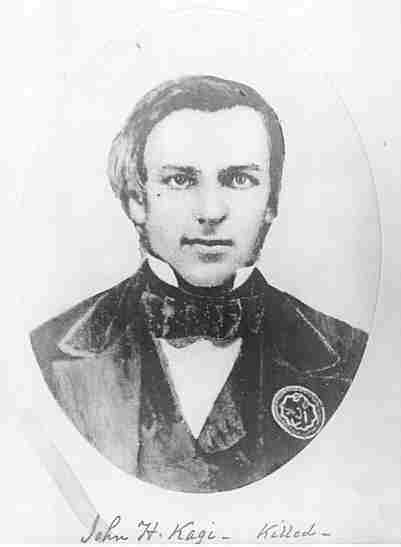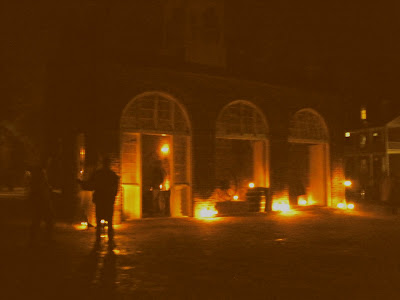We began our evening at the Kennedy Farm, five miles north of Harpers Ferry in Maryland. The log cabin was constructed by Dr. Robert F. Kennedy (no relation to the Massachusetts Kennedys) in 1852. The doctor died in early 1859 and the farm sat vacant for several months.
Brother Mark and I stand in our warm clothing in front of the Kennedy Farm. We feasted on hot apple cider and soup until the program was to begin. We also did some exploring.
John Cook, one of Brown's faithful followers, lived in Harpers Ferry for a year before the raid. He got to know the town and its people very well. When Brown arrived in nearby Sandy Hook, Maryland on July 3, 1859, he discovered this farm was available for rent and found it to be the suitable site for his base of operations.
This view looks west from the "Virginia Fence" of the Kennedy Farm front yard. The mountains in the background are hidden in the misty fog. The clouds of war looming perhaps?
Mark poses with John Brown and his son Owen in the dinning area of the Kennedy Farmhouse. From this room, "Old Osawatomie" and his followers planned their daring raid on Harpers Ferry. The house is completely furnished as it would have been in 1859.
We then ventured into the attic (or garret as they were known back then). Here, weapons, cots, utensils, and everyday items are shown. In this attic, some twenty raiders lived, ate, and slept during the humid summer of 1859. (Annie Brown noted they smelled here too.) They prepared for their mission in the cramped atmosphere for three months. During their frequent free time, they might have played cards or wrote letters as shown above.
Apparently one of the raiders still resides there. Here, I took a seat beside a waxy Shields Green. The twenty three year old man had escaped slavery from Charleston, South Carolina earlier in life. He was introduced to Brown by Frederick Douglass at the latter's home in Chambersburg, Pennsylvania. Green was among those who were sent to capture Colonel Lewis Washington, great grandnephew of George Washington, during the raid. Green was captured and was executed by the Commonwealth of Virginia on December 16, 1859. Douglass noted of Green: "Shields Green was not one to shrink from hardships or dangers. He was a man of few words, and his speech was singularly broken; but his courage and self-respect made him quite a dignified character."

The Kennedy Farm is a National Historic Landmark. It was purchased by Captain South Lynn nearly thirty years ago and has been meticulously restored to its mid-nineteenth century appearance. It has been family owned and operated every since as a private museum. Kudos to the Lynn Family!
A very cool look into the bedroom window of the Kennedy Farm.
One of the first speakers was Alice Keesey Mecoy, great great great granddaughter of John Brown, who recounted Annie Brown's role on the farm. On more than one occasion, Ms. Brown prevented detection of their plot by shewing curious neighbors away. The speakers spoke from the farmhouse's front porch. (Sorry. It was dark out.)

Among the speakers was Park Ranger David Fox of Harpers Ferry National Historical Park. They all read firsthand accounts by the raiders and their acquaintances. We embarked after these excerpts with Ranger Dennis Fry at eight o'clock, the exact same time Brown left the farm, 150 years to the hour. He used the same words of Brown as well: "Men, get on your arms. We shall proceed to the ferry."
Although you wouldn't be able to tell, hundreds of people are in this photo. You can see some of their flashlights, cell phones, and cameras in the darkness. We set out on the march, led by Frye on a horse drawn wagon. We proceeded down the Harpers Ferry Road into the pitch black darkness.

Some four miles later, we made one of our many tour stop at the remains of the former Chesapeake & Ohio Canal (seen at left). Dennis Frye, shown above in 1859 apparel and weaponry, was thrilled about the rather cold and drizzly weather. "It adds a sense of misery and foreboding," he told me beforehand. The raiders experienced very similar weather conditions exactly 150 years previously. A very accurate atmosphere and mood indeed. We followed the C&O Canal pathway for the final mile before we reached the town.

We then finally came upon the lantern lit engine house, the site of John Brown's last stand.

Mark, Dad, and I were among the twenty four people given a candle. Each candle represented one person who was killed as a result of the raid. Fred Morsell (aka Frederick Douglass) read each of their names. Each person came forward and lit their small candle on the much larger one resting on the barrel. We stood there until all the names were read.
Dennis Frye led us with candles behind the engine house. We gathered in a circle. He said he did not know why we were chosen to take part, but we were all chosen for a reason. Like each life that was extinguished, so then were our candles. The name on my candle was John Kagi.



Although you wouldn't be able to tell, hundreds of people are in this photo. You can see some of their flashlights, cell phones, and cameras in the darkness. We set out on the march, led by Frye on a horse drawn wagon. We proceeded down the Harpers Ferry Road into the pitch black darkness.

This map shows the route John Brown (and we) took to Harpers Ferry. Map by Steven Stanley. Courtesy of the Civil War Preservation Trust.
Some four miles later, we made one of our many tour stop at the remains of the former Chesapeake & Ohio Canal (seen at left). Dennis Frye, shown above in 1859 apparel and weaponry, was thrilled about the rather cold and drizzly weather. "It adds a sense of misery and foreboding," he told me beforehand. The raiders experienced very similar weather conditions exactly 150 years previously. A very accurate atmosphere and mood indeed. We followed the C&O Canal pathway for the final mile before we reached the town.

Here is a better view of the bridge in daylight taken from The Point. We crossed the more modern one at far left. Brown and his men crossed the late tin covered bridge at right. Only the stone foundations of it remain. Maryland Heights are shown in the far background.
We then finally came upon the lantern lit engine house, the site of John Brown's last stand.

Over 300 people, wet and probably very tired, began to congregate around the structure for the solemn conclusion of our four hour program. At this point, twenty four people were given candles.
Dennis Frye led us with candles behind the engine house. We gathered in a circle. He said he did not know why we were chosen to take part, but we were all chosen for a reason. Like each life that was extinguished, so then were our candles. The name on my candle was John Kagi.

John Henry Kagi (March 15, 1835 - October 17, 1859) was second in command to Brown in during the raid. He bore the title of "Secretary of War" in Brown's "provisional government." At age 24, Kagi was killed on the second day of the raid.

We took part in further commemorations the next day on October 17. Active members of the United States Marine Corps were present and equipped as the 1859 Marines were. Nearly ninety Marines helped suppress Brown's raid. They were led by Robert E. Lee of the U.S. Cavalry.


Visitors gather at John Brown's Fort for "The Final Assault" program during the John Brown 150th commemoration. NPS photo by Jim Wassel.

"The Point" was the site of the Wager House Hotel in 1859. Over eighty years earlier, Thomas Jefferson wrote, "This scene is worth a voyage across the Atlantic." Here, the Shenandoah River on the right flows into the Potomac River on the left. Washington, D.C. is fifty one miles downstream. The river, arsenal, railroads, bridges, and canal made this a vital strategic position.
David tells us three of the main fears slaveholders had during the times of John Brown. The first was slave revolt, which Brown had hoped to initiate. (The popcorn popping sound is rain hitting my umbrella.)
A second fear was that of a violent abolitionist movement. For years, northerners had been preaching freedom and southerners feared words would be turned into action. John Brown did exactly this.
A third and final fear of white slave owners was simply being outnumbered. Planter elites wanted tax incentives for poorer white southerners to afford slaves. Such a strategy would create harmony between rich and poor planters throughout the south. The idea was never put into practice.
A third and final fear of white slave owners was simply being outnumbered. Planter elites wanted tax incentives for poorer white southerners to afford slaves. Such a strategy would create harmony between rich and poor planters throughout the south. The idea was never put into practice.
In our final video, David describes the final moments of the assault on John Brown in the engine house. We and the Marines are standing inside the fort itself.
I will have more information on John Brown's raid in the coming days. Stay tuned! Special thanks to Dennis Frye, David Fox, Dr. Sandra Petrulionis, and my family for all their help and expertise!
Finally, here is an excellent documentary on the raid via YouTube.
I will have more information on John Brown's raid in the coming days. Stay tuned! Special thanks to Dennis Frye, David Fox, Dr. Sandra Petrulionis, and my family for all their help and expertise!

















Jared,
ReplyDeleteGreat post. I have a clearer picture of the speakers on the porch if you would like a copy.
Alice Keesey Mecoy
Great Great Great Granddaughter of John Brown
amecoy75002@yahoo.com
I really well done blog entry of the re-enactment of John Brown's raid at Harpers Ferry.
ReplyDeleteI enjoyed the pictures and videos, it must have been great to be there!
Thanks!